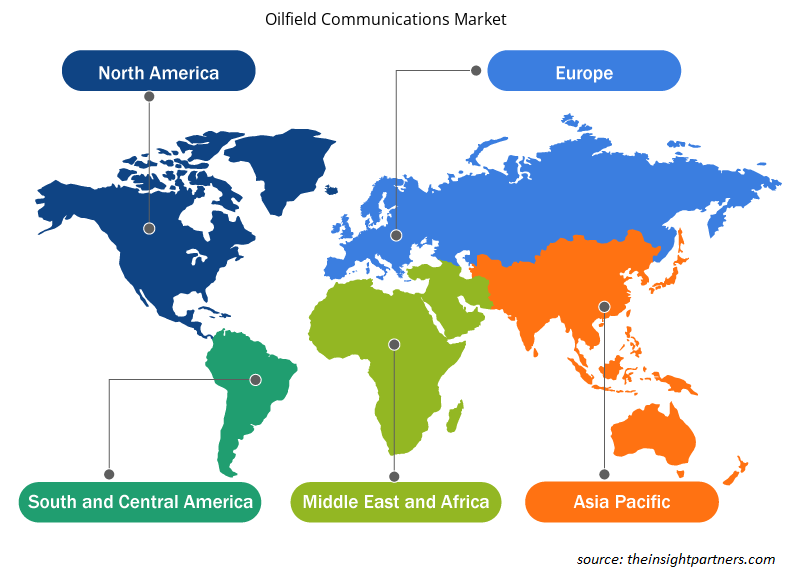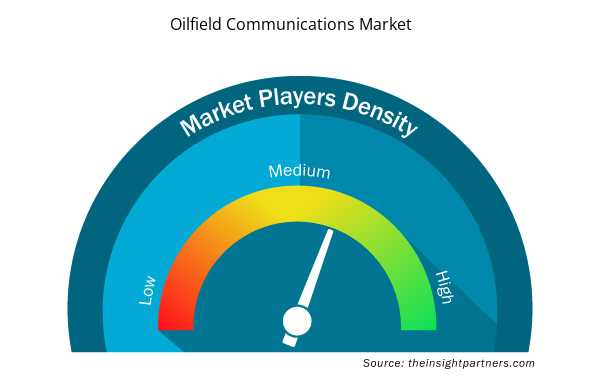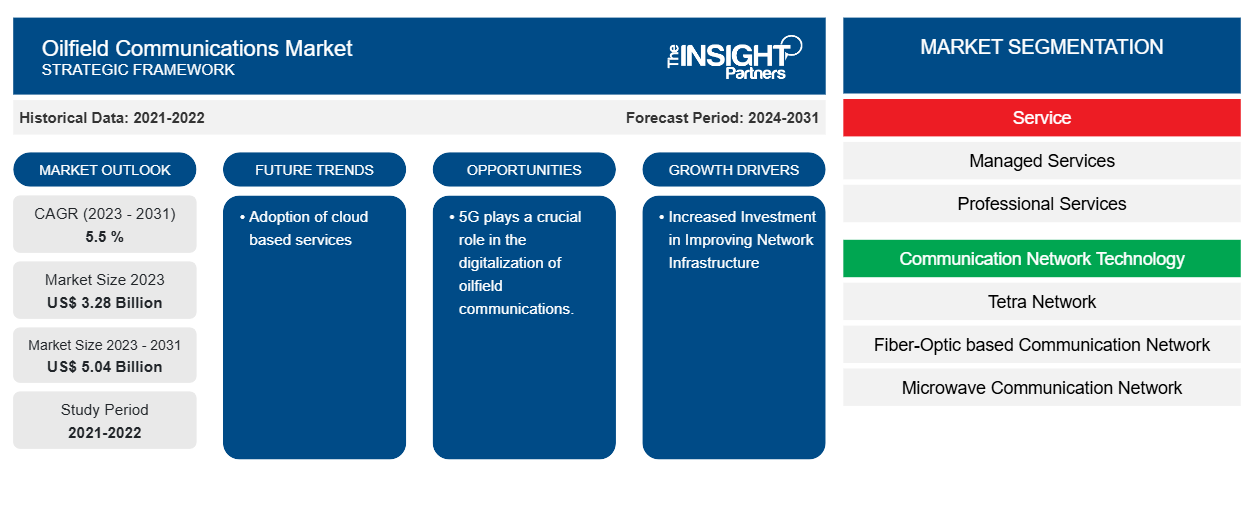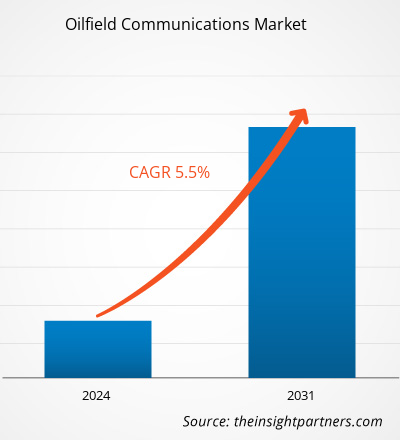Der Markt für Ölfeldkommunikation soll von 3,28 Milliarden US-Dollar im Jahr 2023 auf 5,04 Milliarden US-Dollar im Jahr 2031 anwachsen. Für den Markt wird für den Zeitraum 2023–2031 eine durchschnittliche jährliche Wachstumsrate von 5,5 % erwartet. Der Markt für Ölfeldkommunikation wächst aufgrund erhöhter Investitionen in die Netzwerkinfrastruktur, der gestiegenen Nachfrage von Öl- und Gasbetreibern nach Produktionsausweitung und Fortschritten in der Kommunikationstechnologie.
Ölfeldkommunikation Marktanalyse
Es wird erwartet, dass zunehmende technische Verbesserungen in der Ölfeldkommunikation das Marktwachstum in den kommenden Jahren vorantreiben werden. Darüber hinaus wird erwartet, dass eine steigende Nachfrage nach Kommunikationslösungen mit hoher Bandbreite sowie der Wunsch und die Bemühungen der Branche, Upstream-Anlagen zu verbessern, den Markt während des gesamten Prognosezeitraums antreiben werden. Die zunehmende Nachfrage nach Cloud-basierten Diensten, kombiniert mit einer wachsenden Betonung der Einführung effektiver Kommunikationstechnologie, wird die Nachfrage nach Ölfeldkommunikation verschärfen. Steigende Investitionen in die Netzwerkinfrastruktur sowie das Wachstum und die Expansion der Öl- und Gasindustrie werden dem Markt für Ölfeldkommunikation attraktivere Wachstumspotenziale eröffnen.
Marktübersicht für Ölfeldkommunikation
Ölfeldkommunikation bezieht sich auf Kommunikationssysteme, die mit dem Hauptziel implementiert werden, verschiedene Öl- und Gasunternehmen zu unterstützen oder zu betreuen, die möglicherweise Informationen für die Ölexploration, Produktionsprozesse, Berichtstechnologie, Automatisierung und andere Prozesse benötigen. Der Markt für Ölfeldkommunikation wird durch das exponentielle Wachstum und die breite Akzeptanz von Spitzentechnologien wie künstlicher Intelligenz, maschinellem Lernen , kognitiver Intelligenz und Cloud sowie durch erhöhte Investitionen in die Netzwerkinfrastruktur angetrieben, da für unternehmenskritische Aktivitäten auf den Ölfeldern, die auf konsistente Kommunikation angewiesen sind, zuverlässige Hardware erforderlich ist.
Passen Sie diesen Bericht Ihren Anforderungen an
Sie erhalten kostenlos individuelle Anpassungen an jedem Bericht, einschließlich Teilen dieses Berichts oder einer Analyse auf Länderebene, eines Excel-Datenpakets sowie tolle Angebote und Rabatte für Start-ups und Universitäten.
- Holen Sie sich die wichtigsten Markttrends aus diesem Bericht.Dieses KOSTENLOSE Beispiel umfasst eine Datenanalyse von Markttrends bis hin zu Schätzungen und Prognosen.
Treiber und Chancen auf dem Ölfeldkommunikationsmarkt
Erhöhte Investitionen in die Verbesserung der Netzwerkinfrastruktur zur Förderung des Marktes
Die Öl- und Gasindustrie nutzt seit Jahrzehnten ihre eigenen Telekommunikationsnetze. Diese privat geführten und verwalteten Netze überwachen den täglichen Betrieb und koordinieren im Krisenfall die Notdienste. Moderne unternehmenskritische Netze stehen vor zwei Herausforderungen. Erstens besteht Modernisierungsbedarf. Echtzeitdaten, anspruchsvolle Steuerung und Überwachung sowie hohe Sicherheit erfordern eine Infrastruktur, die über die Fähigkeiten von Schmalbandnetzen hinausgeht. Zweitens muss eine qualitativ hochwertige Kommunikation sichergestellt werden. Für die Kommunikation in Öl- und Gasfeldern sind drahtlose Netzwerke mit hoher Kapazität erforderlich, die auch in rauen Umgebungen funktionieren.
5G spielt bei der Digitalisierung der Ölfeldkommunikation eine entscheidende Rolle.
Die Öl- und Gasindustrie kann von privaten Long-Term Evolution (LTE)- und 5G-Netzen profitieren, da die 4G-Funktechnologie schnell angenommen wird und sich 5G-Standards für industrielle Anwendungsfälle entwickeln. Die Ambitionen der Öl- und Gasindustrie hinsichtlich der Einführung von 5G bleiben ungewiss. Es wird erwartet, dass die 5G-Technologie Öl- und Gasunternehmen in Zukunft einen erheblichen Wettbewerbsvorteil verschaffen wird. Öl-E&P-Unternehmen legen Wert auf Effizienz und Agilität, was zu ehrgeizigen digitalen Anstrengungen führt. 5G bietet Vorteile in der Öl- und Gasindustrie, darunter Ultra-Reliable Latency Communication (URLLC) und Machine Type Communication (MMTC).
Segmentierungsanalyse des Marktberichts zur Ölfeldkommunikation
Wichtige Segmente, die zur Ableitung der Marktanalyse für Ölfeldkommunikation beigetragen haben, sind Service, Kommunikationsnetzwerktechnologie, Feldstandort und Lösung.
- Basierend auf dem Service ist der Markt für Ölfeldkommunikation in Managed Services und Professional Services segmentiert.
- Basierend auf der Kommunikationsnetzwerktechnologie ist der Markt für Ölfeldkommunikation in Tetra-Netzwerke, glasfaserbasierte Kommunikationsnetzwerke, Mikrowellen-Kommunikationsnetzwerke, Mobilfunk-Kommunikationsnetzwerke und VSAT-Kommunikationsnetzwerke segmentiert.
- Basierend auf der Feldlage ist der Markt für Ölfeldkommunikation in Onshore-Kommunikation und Offshore-Kommunikation segmentiert.
- In Bezug auf die Lösungen ist der Markt in Midstream-Kommunikationslösungen, Downstream-Kommunikationslösungen und Upstream-Kommunikationslösungen segmentiert.
Ölfeldkommunikation Marktanteilsanalyse nach Geografie
Der geografische Umfang des Berichts zum Ölfeldkommunikationsmarkt ist hauptsächlich in fünf Regionen unterteilt: Nordamerika, Asien-Pazifik, Europa, Naher Osten und Afrika sowie Südamerika/Süd- und Mittelamerika. Nordamerikanische Firmen suchen nach hochmodernen digitalen Kommunikationslösungen für ihre Onshore- und Offshore-Felder. Viele Öl produzierende Unternehmen haben ihren Hauptsitz in den USA. Die meisten Unternehmen testen neue Dienste in ihrem eigenen Land, bevor sie sie international einführen. Die schnelle Einführung neuer Technologien in diesem Land sowie die zunehmende Betonung weltweiter Kommunikation treiben den Markt voran.
Regionale Einblicke in den Ölfeldkommunikationsmarkt
Die regionalen Trends und Faktoren, die den Ölfeldkommunikationsmarkt während des Prognosezeitraums beeinflussen, wurden von den Analysten von Insight Partners ausführlich erläutert. In diesem Abschnitt werden auch die Marktsegmente und die Geografie des Ölfeldkommunikationsmarkts in Nordamerika, Europa, im asiatisch-pazifischen Raum, im Nahen Osten und Afrika sowie in Süd- und Mittelamerika erörtert.

- Erhalten Sie regionale Daten zum Ölfeldkommunikationsmarkt
Umfang des Marktberichts zur Ölfeldkommunikation
| Berichtsattribut | Details |
|---|---|
| Marktgröße im Jahr 2023 | 3,28 Milliarden US-Dollar |
| Marktgröße bis 2031 | 5,04 Milliarden US-Dollar |
| Globale CAGR (2023 - 2031) | 5,5 % |
| Historische Daten | 2021-2022 |
| Prognosezeitraum | 2024–2031 |
| Abgedeckte Segmente | Nach Service
|
| Abgedeckte Regionen und Länder | Nordamerika
|
| Marktführer und wichtige Unternehmensprofile |
|
Dichte der Marktteilnehmer für Ölfeldkommunikation: Die Auswirkungen auf die Geschäftsdynamik verstehen
Der Markt für Ölfeldkommunikation wächst rasant, angetrieben durch die steigende Nachfrage der Endnutzer aufgrund von Faktoren wie sich entwickelnden Verbraucherpräferenzen, technologischen Fortschritten und einem größeren Bewusstsein für die Vorteile des Produkts. Mit steigender Nachfrage erweitern Unternehmen ihr Angebot, entwickeln Innovationen, um die Bedürfnisse der Verbraucher zu erfüllen, und nutzen neue Trends, was das Marktwachstum weiter ankurbelt.
Die Marktteilnehmerdichte bezieht sich auf die Verteilung von Firmen oder Unternehmen, die in einem bestimmten Markt oder einer bestimmten Branche tätig sind. Sie gibt an, wie viele Wettbewerber (Marktteilnehmer) in einem bestimmten Marktraum im Verhältnis zu seiner Größe oder seinem gesamten Marktwert präsent sind.
Die wichtigsten auf dem Markt für Ölfeldkommunikation tätigen Unternehmen sind:
- ABB Ltd
- Airspan Networks Inc.
- Baker Huges Incorporated
- Ceragon Networks Ltd.
- Commscope Holding Company, Inc.
- Commtel Networks Pvt. GmbH.
Haftungsausschluss : Die oben aufgeführten Unternehmen sind nicht in einer bestimmten Reihenfolge aufgeführt.

- Überblick über die wichtigsten Akteure auf dem Ölfeldkommunikationsmarkt
Nachrichten und aktuelle Entwicklungen zum Ölfeldkommunikationsmarkt
Der Markt für Ölfeldkommunikation wird durch die Erhebung qualitativer und quantitativer Daten nach Primär- und Sekundärforschung bewertet, die wichtige Unternehmensveröffentlichungen, Verbandsdaten und Datenbanken umfasst. Im Folgenden finden Sie eine Liste der Entwicklungen auf dem Markt:
- Im Mai 2022 haben Ericsson und Tampnet zusammengearbeitet, um IoT-Verbindungen für Offshore-Unternehmen zu verwalten. Moderne Sensoren und Fernüberwachungstechnologien können in einer Vielzahl von Offshore-Anwendungsfällen an Personen und Objekten installiert und dank der Verwaltungsfunktionen des Ericsson IoT Accelerator in Echtzeit verbunden werden.
(Quelle: Ericsson, Unternehmenswebsite, 2022)
- Im Dezember 2022 arbeiteten DeepOcean und Akvaplan-Niva zusammen, um die Umweltauswirkungen der Offshore-Wind-, Öl- und Gasförderung mithilfe ferngesteuerter Fahrzeuge (ROVs) und unbemannter Gleitfahrzeuge (USVs) zu bewerten.
(Quelle: DeepOcean, Unternehmenswebsite, 2023)
Marktbericht zur Ölfeldkommunikation – Umfang und Ergebnisse
Der Bericht „Marktgröße und Prognose für Ölfeldkommunikation (2021–2031)“ bietet eine detaillierte Analyse des Marktes, die die folgenden Bereiche abdeckt:
- Marktgröße und Prognose auf globaler, regionaler und Länderebene für alle wichtigen Marktsegmente, die im Rahmen des Projekts abgedeckt sind
- Marktdynamik wie Treiber, Beschränkungen und wichtige Chancen
- Wichtige Zukunftstrends
- Detaillierte PEST/Porters Five Forces- und SWOT-Analyse
- Globale und regionale Marktanalyse mit wichtigen Markttrends, wichtigen Akteuren, Vorschriften und aktuellen Marktentwicklungen
- Branchenlandschaft und Wettbewerbsanalyse, einschließlich Marktkonzentration, Heatmap-Analyse, prominenten Akteuren und aktuellen Entwicklungen
- Detaillierte Firmenprofile
- Historische Analyse (2 Jahre), Basisjahr, Prognose (7 Jahre) mit CAGR
- PEST- und SWOT-Analyse
- Marktgröße Wert/Volumen – Global, Regional, Land
- Branche und Wettbewerbsumfeld
- Excel-Datensatz


- Quantitative Structure-Activity Relationship (QSAR) Market
- Digital Pathology Market
- Emergency Department Information System (EDIS) Market
- Military Rubber Tracks Market
- Electronic Health Record Market
- Artificial Turf Market
- Micro-Surgical Robot Market
- Railway Braking System Market
- Redistribution Layer Material Market
- Mice Model Market

Report Coverage
Revenue forecast, Company Analysis, Industry landscape, Growth factors, and Trends

Segment Covered
This text is related
to segments covered.

Regional Scope
North America, Europe, Asia Pacific, Middle East & Africa, South & Central America

Country Scope
This text is related
to country scope.
Häufig gestellte Fragen
The global oilfield communications market is expected to reach US$ 5.04 billion by 2031.
The key players holding the majority of shares in the global oilfield communications market are ABB Ltd., Airspan Networks Inc., Baker Huges Incorporated, Ceragon Networks Ltd., and Commscope Holding Company, Inc.
Adoption of cloud based services to play a significant role in the global oilfield communications market in the coming years.
Increased investment in improving network infrastructure is the major factors that propel the global oilfield communications market.
The global oilfield communications market was estimated to be US$ 3.28 billion in 2023 and is expected to grow at a CAGR of 5.5% during the forecast period 2023 - 2031.
Trends and growth analysis reports related to Technology, Media and Telecommunications : READ MORE..
The Insight Partners performs research in 4 major stages: Data Collection & Secondary Research, Primary Research, Data Analysis and Data Triangulation & Final Review.
- Data Collection and Secondary Research:
As a market research and consulting firm operating from a decade, we have published and advised several client across the globe. First step for any study will start with an assessment of currently available data and insights from existing reports. Further, historical and current market information is collected from Investor Presentations, Annual Reports, SEC Filings, etc., and other information related to company’s performance and market positioning are gathered from Paid Databases (Factiva, Hoovers, and Reuters) and various other publications available in public domain.
Several associations trade associates, technical forums, institutes, societies and organization are accessed to gain technical as well as market related insights through their publications such as research papers, blogs and press releases related to the studies are referred to get cues about the market. Further, white papers, journals, magazines, and other news articles published in last 3 years are scrutinized and analyzed to understand the current market trends.
- Primary Research:
The primarily interview analysis comprise of data obtained from industry participants interview and answers to survey questions gathered by in-house primary team.
For primary research, interviews are conducted with industry experts/CEOs/Marketing Managers/VPs/Subject Matter Experts from both demand and supply side to get a 360-degree view of the market. The primary team conducts several interviews based on the complexity of the markets to understand the various market trends and dynamics which makes research more credible and precise.
A typical research interview fulfils the following functions:
- Provides first-hand information on the market size, market trends, growth trends, competitive landscape, and outlook
- Validates and strengthens in-house secondary research findings
- Develops the analysis team’s expertise and market understanding
Primary research involves email interactions and telephone interviews for each market, category, segment, and sub-segment across geographies. The participants who typically take part in such a process include, but are not limited to:
- Industry participants: VPs, business development managers, market intelligence managers and national sales managers
- Outside experts: Valuation experts, research analysts and key opinion leaders specializing in the electronics and semiconductor industry.
Below is the breakup of our primary respondents by company, designation, and region:

Once we receive the confirmation from primary research sources or primary respondents, we finalize the base year market estimation and forecast the data as per the macroeconomic and microeconomic factors assessed during data collection.
- Data Analysis:
Once data is validated through both secondary as well as primary respondents, we finalize the market estimations by hypothesis formulation and factor analysis at regional and country level.
- Macro-Economic Factor Analysis:
We analyse macroeconomic indicators such the gross domestic product (GDP), increase in the demand for goods and services across industries, technological advancement, regional economic growth, governmental policies, the influence of COVID-19, PEST analysis, and other aspects. This analysis aids in setting benchmarks for various nations/regions and approximating market splits. Additionally, the general trend of the aforementioned components aid in determining the market's development possibilities.
- Country Level Data:
Various factors that are especially aligned to the country are taken into account to determine the market size for a certain area and country, including the presence of vendors, such as headquarters and offices, the country's GDP, demand patterns, and industry growth. To comprehend the market dynamics for the nation, a number of growth variables, inhibitors, application areas, and current market trends are researched. The aforementioned elements aid in determining the country's overall market's growth potential.
- Company Profile:
The “Table of Contents” is formulated by listing and analyzing more than 25 - 30 companies operating in the market ecosystem across geographies. However, we profile only 10 companies as a standard practice in our syndicate reports. These 10 companies comprise leading, emerging, and regional players. Nonetheless, our analysis is not restricted to the 10 listed companies, we also analyze other companies present in the market to develop a holistic view and understand the prevailing trends. The “Company Profiles” section in the report covers key facts, business description, products & services, financial information, SWOT analysis, and key developments. The financial information presented is extracted from the annual reports and official documents of the publicly listed companies. Upon collecting the information for the sections of respective companies, we verify them via various primary sources and then compile the data in respective company profiles. The company level information helps us in deriving the base number as well as in forecasting the market size.
- Developing Base Number:
Aggregation of sales statistics (2020-2022) and macro-economic factor, and other secondary and primary research insights are utilized to arrive at base number and related market shares for 2022. The data gaps are identified in this step and relevant market data is analyzed, collected from paid primary interviews or databases. On finalizing the base year market size, forecasts are developed on the basis of macro-economic, industry and market growth factors and company level analysis.
- Data Triangulation and Final Review:
The market findings and base year market size calculations are validated from supply as well as demand side. Demand side validations are based on macro-economic factor analysis and benchmarks for respective regions and countries. In case of supply side validations, revenues of major companies are estimated (in case not available) based on industry benchmark, approximate number of employees, product portfolio, and primary interviews revenues are gathered. Further revenue from target product/service segment is assessed to avoid overshooting of market statistics. In case of heavy deviations between supply and demand side values, all thes steps are repeated to achieve synchronization.
We follow an iterative model, wherein we share our research findings with Subject Matter Experts (SME’s) and Key Opinion Leaders (KOLs) until consensus view of the market is not formulated – this model negates any drastic deviation in the opinions of experts. Only validated and universally acceptable research findings are quoted in our reports.
We have important check points that we use to validate our research findings – which we call – data triangulation, where we validate the information, we generate from secondary sources with primary interviews and then we re-validate with our internal data bases and Subject matter experts. This comprehensive model enables us to deliver high quality, reliable data in shortest possible time.


 Holen Sie sich ein kostenloses Muster für diesen Bericht
Holen Sie sich ein kostenloses Muster für diesen Bericht